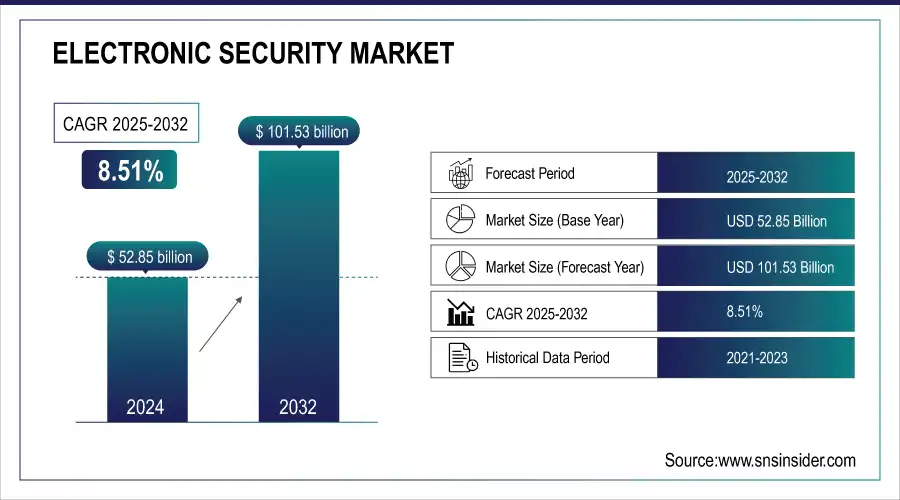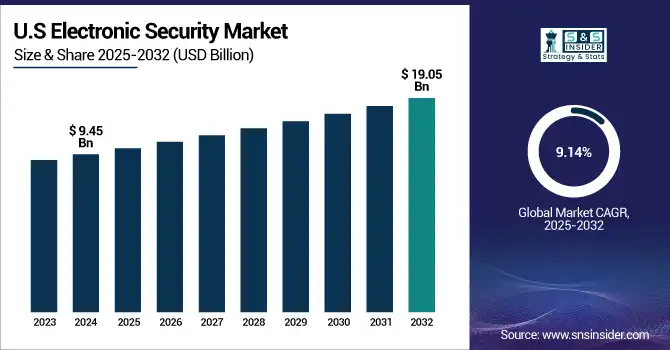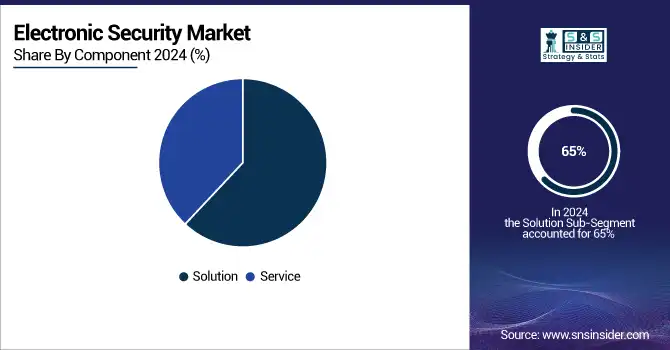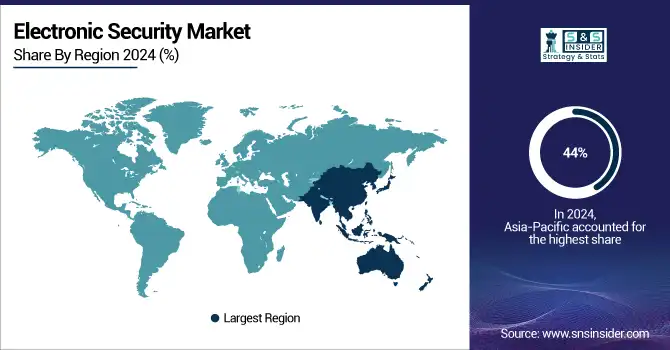Electronic Security Market Size & Growth:
The Electronic Security Market size was valued at USD 52.85 Billion in 2024 and is projected to reach USD 101.53 Billion by 2032, growing at a CAGR of 8.51% during 2025-2032.
The electronic security market is experiencing rapid innovation driven by advancements in AI, autonomous systems, and multi-sensor integration. This solution identifies new and novel threats in real-time for increased situational awareness, advanced security staff education, with reduced false alarms by providing multi-source data fusion analytics. Connected Sensor Systems Radar, video and Unmanned Aerial platforms linked together provide a proactive and automated response for wide area high-risk environments. These developments are transforming reactive security models into intelligent, adaptive frameworks for fixed and mobile infrastructure These systems are capable of scaling, being modular towards these types of solution factors in terms of lower detections and higher manpower mobilization. This indicates the trend in rising expenditure on AI equipped electronic security for the mission-critical or government-owned premises.

To Get more information on Electronic Security Market - Request Free Sample Report
Huntsville Center tested AI-enabled security solutions such as PRISM and Scylla AI to provide real-time threat discovery, and autonomous response at Blue Grass Army Depot. These will be used in future ESS contract deployments to improve DoD installation security.
The U.S Electronic Security Market size was valued at USD 9.45 Billion in 2024 and is projected to reach USD 19.05 Billion by 2032, growing at a CAGR of 9.14% during 2025-2032. Electronic Security Market growth is driven by rising adoption of AI-based surveillance, integrated sensor platforms, and autonomous systems that enhance real-time threat detection and reduce human intervention. Deployment across defense installations, critical infrastructure, and government facilities is accelerating, supported by modular architectures, remote diagnostics, and secure firmware integration.

The electronic security market trends include growing integration of AI-powered video analytics, facial recognition, and sensor fusion technologies to enhance situational awareness and threat detection. Autonomous surveillance systems, including drones and robotic patrol units, are gaining traction for perimeter security. There's a strong shift toward modular, scalable platforms that support secure firmware, real-time data processing, and remote management. Demand is rising for cybersecurity-hardened systems, digital twin applications for predictive maintenance, and seamless interoperability between multi-vendor security solutions across government, military, and critical infrastructure deployments.
Electronic Security Market Dynamics:
Drivers:
-
Diversification Strategies Fuel Electronic Security Market Growth
The electronic security market is witnessing strong growth as organizations increasingly diversify beyond traditional hardware and consumer electronics into high-value security solutions. That trend reflects a broader trajectory toward scalable, subscription-based recurring revenue and growing customer interest in surveillance, video analytics, access control, and other integrated systems. To grow the B2B services pie, companies are further diversifying their service inventory and exploring newer segments like Electronic Security that offer relatively better profitability and market resilience. This has resulted in increased investment, innovation and emerging competitive dynamics across the sector driving continued adoption in both private and public infrastructure and strengthening the market growth trajectory over time.
Positivo Tecnologia focused its presentation on its electronic security unit, Positivo Seg, which registered 90% revenue growth and is becoming more present in the B2B space. Vale a pena notar que isto é consistente com os propósitos daquela para desmamar-se em parte dos PC´s e smartphones, além de acessar o mercado de segurança eletrônica do Brasil cujo valor chegará a BRL 25,3B até 2028.
Restraints:
-
Fragmented Ecosystems and Integration Barriers Limit Security Technology Adoption
Adoption of advanced electronic security solutions is hindered by fragmented ecosystems and difficulties in integrating multi-vendor systems. Diverse hardware & software platforms have compatibility issues, and often do not function effectively with other systems which results in complexities, longer time to deploy, higher maintenance costs. The issue is that smaller providers do not have the resources to provide standardized, scalable solutions and strong cybersecurity with a life cycle of long term sustainable support. The second is limited product traction, subpar sales execution and nascent distribution networks means much less to fewer customers. In turn, businesses are finding it difficult to achieve integrated security capabilities and delivery of information security operations that lead to increasingly delayed digital transformation projects as well as a decrease in the ROI for next-generation cybersecurity solutions.
Opportunities:
-
Transition to Digital Ownership Records Unlocks New Opportunities for Secure Tech Solutions
The move toward digital ownership records is driving demand for advanced electronic document management, secure cloud infrastructure, and data encryption technologies. As organizations and governments digitize critical records, opportunities emerge for providers of identity authentication, multi-layered cybersecurity, and tamper-proof storage solutions. This creates room for innovation in digital trust services, blockchain-based verification, and seamless integration tools to support secure access and long-term data integrity. The need for efficient, user-friendly, and scalable systems is encouraging investment in platforms that can handle high-volume transactions while maintaining compliance, privacy, and resilience against cyber threats.
Indonesia Advances Electronic Land Certificates with 28% Migration CompletedMinister Nusron Wahid stated the shift will simplify ownership verification and boost security through multi-layered data protection and secure physical backups.
Challenges:
-
Complex Deployment and Evolving Threats Challenge Electronic Security Implementation
The electronic security sector faces key challenges due to complex system integration, evolving cyber threats, and high upfront investment requirements. Implementing new advanced surveillance, access control and threat detection technologies further exacerbate compliance challenges because of the incompatibility often between legacy systems which were not designed to work with modern systems which can result in delays and increased costs. And as well as getting more clever, threat actors are causing a bigger headache by becoming so much more connected that the cybersecurity risks of traditional isolated devices have to start flirting with standard 'oh God, this is all going skyward' IoT security. More so, the shortage of qualified professionals in cyber security and system engineering also delays proper implementation. Such challenges decrease operational efficiency, retard the deployment in mission-critical scenarios, and trigger questions about long-term life and maintenance of intelligent & secure infrastructure impeding the real potential of it across industries.
Electronic Security Market Segmentation Analysis:
By Component
In 2024, the Solution segment accounted for approximately 65% of the Electronic Security market share, highlighting its dominant role in current defense operations. highlighting its dominant role in current defense operations. This strong market stance is driven by rising demand for integrated surveillance, access control, and intelligent monitoring platforms that offer end-to-end threat detection and response capabilities.
The Service segment is expected to experience the fastest growth in Electronic Security market over 2025-2032 with a CAGR of 10.98%, due to increasing demand for managed security services and system maintenance remote monitoring & cloud-based threat analytics. Increasing trend towards transitioning to service-based models in order to augment flexibility and reduce workload has been stimulating the penetration across public as well as private sector organizations and sustained growth in this segment.

By Deployment Mode
In 2024, the On-premises segment accounted for approximately 58% of the Electronic Security market share, reflecting strong demand for localized data control, lower latency, and customized system configurations. This preference is particularly prevalent in high-security environments such as defense, government, and critical infrastructure, where direct oversight and regulatory compliance are essential.
The Cloud-based segment is expected to experience the fastest growth in Electronic Security market over 2025-2032 with a CAGR of 12.26% owing to increase in demand for scalable, remotely managed security solutions with real time analytics and cost vulnerability deployment models Accelerating the trend toward flexibility, seamless updates, and more robust disaster recovery for enterprise and public sector applications alike.
By Connectivity
In 2024, the Ethernet segment accounted for approximately 48% of the Electronic Security market share, underscoring its role as the preferred communication standard for high-speed, reliable data transmission. Its dominance is supported by widespread deployment in video surveillance, access control, and alarm systems, offering stability, low latency, and ease of integration across enterprise and critical infrastructure environments.
The Cellular segment is expected to experience the fastest growth in Electronic Security market over 2025-2032 with a CAGR of 16.70% as demand for mobile, remote and decentralized security systems that require flexible connectivity solution to rise. Cellular networks provide fast roll-out in places where there is little static infrastructure and can deliver real-time monitoring and alert systems in both urban settings and remote regions, well-suited for smart cities, mobile patrols, and emergency response use cases.
By Application
In 2024, the Public Sector segment accounted for approximately 22% of the Electronic Security market share, reflecting sustained spending on national defense, public safety, and infrastructure protection. To tackle increasing security threats, governments are using sophisticated surveillance along with access control and threat detection systems in urban zones, transport hubs, government buildings. The percentage of this segment indicates the importance of electronic security in national resilience, regulatory compliance, and public trust initiatives.
The Telecommunications segment is expected to experience the fastest growth in Electronic Security market over 2025-2032 with a CAGR of 11.91%, owing to increasing requirement to secure large networks, data centers as well as mobile infrastructure from increasing cyber and physical threats. Without question, the demand for integrated security solutions — such as those for intrusion detection and access control and real-time monitoring — is services markets similarly advance 5G + IoT networks from telecom providers into both core and edge environments.
Electronic Security Market Regional Outlook:
In 2024 Asia-Pacific dominated the Electronic Security market and accounted for 44% of revenue share, owing to rapid urbanization and implementation of smart city initiatives driving growing investments in public safety infrastructure. Large scale surveillance is also being deployed in countries such as China, India, Japan that uses similar mechanism; integrated surveillance and access control system (referred to as 'all-in-one control' in CH) across transport systems, government sector and commercial sectors. Accompanied by the rapid growth of the region's factory floor, as well as escalating security threats, demand for advanced integrated electronic security solutions is on the rise both in public and private sectors.

Get Customized Report as per Your Business Requirement - Enquiry Now
North America is expected to witness the fastest growth in the Electronic Security market over 2025-2032, with a projected CAGR of 10.20%, This growth is fueled by increasing adoption of AI-driven surveillance, cloud-based security platforms, and advanced access control systems across government, commercial, and critical infrastructure sectors. Heightened concerns around cyber-physical threats, strong regulatory frameworks, and continuous technological innovation are driving accelerated investments in integrated and scalable electronic security solutions throughout the region.
In 2024, Europe emerged as a promising region in the Electronic Security market, rising infrastructure modernization, and growing focus on public safety. Countries like Germany, France, and the UK are investing in intelligent surveillance, access control, and cybersecurity-integrated systems across urban, transportation, and government facilities, driving steady demand for advanced electronic security solutions.
Latin America (LATAM) and the Middle East & Africa (MEA) regions are witnessing steady growth in the Electronic Security market, huge infrastructural investments, along with increase in security concerns across commercial and public sectors. Modern surveillance, access control and perimeter security systems are required to be installed by governments and private enterprises in countries such as Brazil, Mexico, UAE and Saudi Arabia. Increased understanding of digital threats and moves to bolster national security frameworks also help to underpin adoption in these new markets.
Electronic Security Companies are:
The Key Players in Electronic Security Market are Siemens, ABB, Schneider Electric, Eaton, General Electric, CG Power, Meidensha, Honeywell International, Johnson Controls, Bosch Security Systems, Hikvision, Axis Communications, Tyco International, FLIR Systems, Panasonic, ADT, Dahua Technology, Thales Group, ASSA ABLOY,NEC Corporation. and Others.
Recent Developments:
-
In April 2025, Secafy selects Siemens’ full IC design flow to advance next-gen hardware security LSI development. The collaboration leverages Siemens’ Aprisa, Calibre, Solido Suite, and custom IC tools to enhance semiconductor-level cybersecurity.
-
In Nov 2025, Schneider Electric confirms breach of its developer platform after 40GB of sensitive project and user data was stolen via exposed credentials and a REST API exploit.
| Report Attributes | Details |
|---|---|
| Market Size in 2024 | USD 52.85 Billion |
| Market Size by 2032 | USD 101.53 Billion |
| CAGR | CAGR of 8.51% From 2024 to 2032 |
| Base Year | 2024 |
| Forecast Period | 2025-2032 |
| Historical Data | 2021-2023 |
| Report Scope & Coverage | Market Size, Segments Analysis, Competitive Landscape, Regional Analysis, DROC & SWOT Analysis, Forecast Outlook |
| Key Segments | • By Component (Solution and Service) • By Deployment Mode (On-premises and Cloud-based) • By Connectivity (Ethernet, Wireless and Cellular) • By Application (Environmental, Public Sector, Customs Service Sector, Postal, Telecommunications, Residential and Others) |
| Regional Analysis/Coverage | North America (US, Canada), Europe (Germany, UK, France, Italy, Spain, Russia, Poland, Rest of Europe), Asia Pacific (China, India, Japan, South Korea, Australia, ASEAN Countries, Rest of Asia Pacific), Middle East & Africa (UAE, Saudi Arabia, Qatar, South Africa, Rest of Middle East & Africa), Latin America (Brazil, Argentina, Mexico, Colombia, Rest of Latin America). |
| Company Profiles | The Electronic Security market Companies are Siemens, ABB, Schneider Electric, Eaton, General Electric, CG Power, Meidensha, Honeywell International, Johnson Controls, Bosch Security Systems, Hikvision, Axis Communications, Tyco International, FLIR Systems, Panasonic, ADT, Dahua Technology, Thales Group, ASSA ABLOY,NEC Corporation. and Others. |

